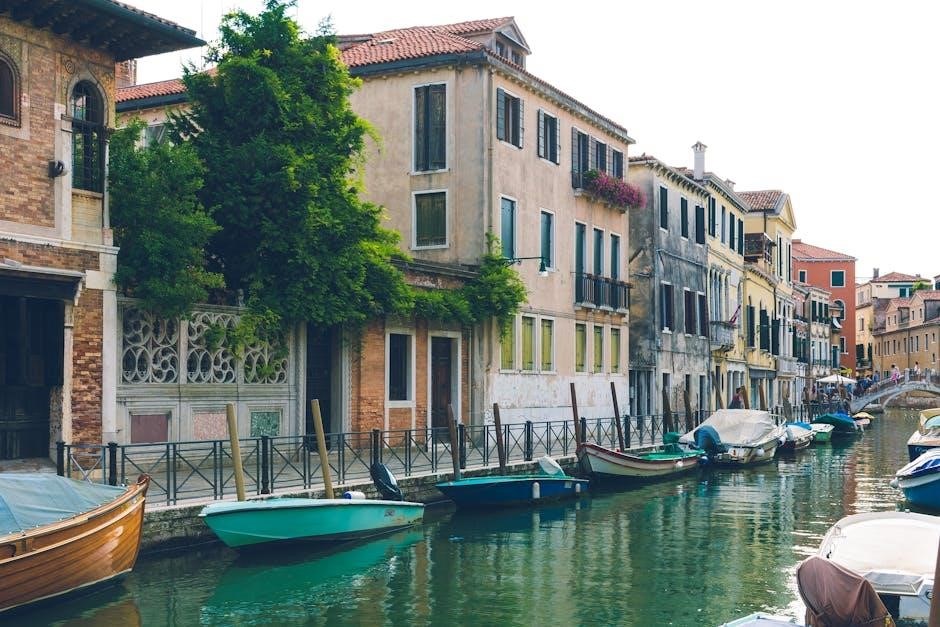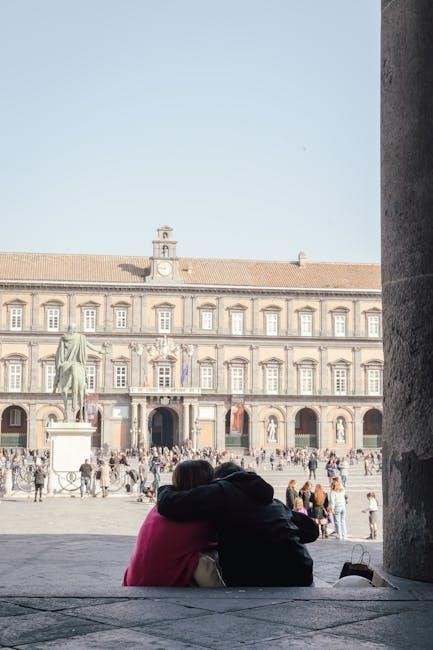
Romeo and Juliet, a tragic love story by William Shakespeare, revolves around the feud between the Montagues and Capulets in Verona. The play explores themes of love, fate, and societal conflict, culminating in the heartbreaking demise of the star-crossed lovers, leaving a lasting impact on literature and culture.
1.1. Background of the Play
Romeo and Juliet is a tragic play set in Verona, Italy, centered on the ancient feud between the Montagues and Capulets. Based on an older narrative poem, Shakespeare adapted the story to explore themes of love, fate, and societal conflict. The play’s backdrop of familial hatred creates tension, driving the plot toward its inevitable tragic conclusion. Verona’s divided society highlights the clash between personal desire and societal expectations, setting the stage for the ill-fated romance of the two protagonists. This historical and cultural context provides the foundation for the play’s enduring exploration of universal human emotions and conflicts.
1.2. The Feud Between Montagues and Capulets
The bitter feud between the Montagues and Capulets fuels the tragic events of Romeo and Juliet. Originating from a forgotten dispute, this longstanding animosity divides Verona, creating a hostile environment where violence and hatred prevail. The families’ rivalry is so entrenched that even their servants exhibit deep-seated hatred. Public confrontations and duels frequently erupt, showcasing the destructive nature of their vendetta. This relentless cycle of vengeance traps Romeo and Juliet, whose love becomes a casualty of the families’ unyielding hatred. The feud serves as both a backdrop and a catalyst for the play’s tragic progression, emphasizing the devastating cost of unchecked animosity.
1.3. The Tragic Love Story
Romeo and Juliet’s tale is a poignant exploration of youthful passion and doomed love. Their whirlwind romance blossoms despite the animosity between their families, showcasing the redemptive power of love. The balcony scene captures the intensity of their emotions, as they pledge devotion in secret. Their hasty marriage, facilitated by Friar Laurence, symbolizes hope for reconciliation but ultimately accelerates their fate. The story’s tragic conclusion underscores the destructive force of impulsive decisions and the enduring legacy of their love, leaving a profound impact on literature and art, eternalizing their story as a timeless symbol of star-crossed lovers.

Plot Summary of Romeo and Juliet
Romeo and Juliet, from feuding families, fall in love, marry secretly, and ultimately die, ending the bitter rivalry between the Montagues and Capulets in Verona.
Act 1 introduces the feud between the Montagues and Capulets, setting the stage for the tragic events. Romeo, a Montague, pines for Rosaline, while Juliet, a Capulet, prepares for marriage. At a Capulet ball, Romeo and Juliet meet, falling deeply in love. Their families’ animosity intensifies the conflict, as they realize their love is forbidden. The act ends with Romeo’s impulsive decision to marry Juliet, defying the families’ hatred, thus escalating the inevitable tragic outcome.
2.2. Act 2: The Secret Marriage
In Act 2, Romeo and Juliet’s love deepens as they exchange vows in a secret ceremony officiated by Friar Laurence, who hopes their union will end the families’ feud. Juliet’s balcony declaration of love showcases her determination, while Romeo’s passion drives him to risk everything for their marriage. The act highlights the intensity of their emotions and the societal obstacles they face, setting the stage for the tragic events that follow.
2.3. Act 3: The Tragic Turn of Events
Act 3 marks a devastating shift in the story as tensions escalate. Tybalt, fueled by hatred for the Montagues, challenges Romeo to a duel. When Romeo refuses to fight, Mercutio steps in and is fatally wounded by Tybalt. Enraged, Romeo avenges Mercutio’s death by killing Tybalt, leading to his banishment from Verona. Meanwhile, Juliet’s parents arrange her marriage to Paris, unaware of her secret marriage to Romeo; The act ends with Romeo and Juliet sharing a heartbreaking farewell, setting the stage for the impending tragedy that will unfold.
2.4. Act 4: Juliet’s Fake Death
In Act 4, Juliet faces a desperate dilemma as her parents insist she marry Paris. To avoid this, she turns to Friar Laurence, who gives her a potion to make her appear dead. Juliet drinks the potion and is found lifeless by her family, who mourn her apparent demise. Meanwhile, Romeo, unaware of the plan, believes Juliet is truly dead and decides to end his life. The act heightens the emotional tension as Juliet’s fake death sets the stage for the tragic events that will unfold, showcasing the desperation and sacrifice of the young lovers.
2.5. Act 5: The Tragic Ending
In Act 5, the tragic conclusion unfolds as Romeo, believing Juliet is dead, poisons himself in her tomb. Juliet awakens to find Romeo dead and, in grief, stabs herself with his dagger to join him in death. The tragic ending ultimately brings peace between the feuding families, as they realize the senseless loss of their children. The play concludes with a reflection on the devastating cost of their long-standing hatred, emphasizing the redemptive power of love and the inevitability of fate. The lovers’ deaths serve as a poignant reminder of the destructive nature of unresolved conflict.

Main Characters in Romeo and Juliet
Romeo, a passionate Montague, and Juliet, a determined Capulet, are the star-crossed lovers. Friar Laurence, a wise mentor, Tybalt, Juliet’s aggressive cousin, and the loyal Nurse shape the story.
3.1. Romeo Montague
Romeo Montague is a young, handsome, and sensitive nobleman from Verona. He begins as a lovesick youth pining for Rosaline but transforms into a passionate lover when he meets Juliet. His impulsive nature often leads to rash decisions, such as secretly marrying Juliet and dueling with Tybalt. Romeo’s character evolves from a romantic idealist to a tragic figure willing to sacrifice everything for love. His emotional depth and poetic language make him one of Shakespeare’s most iconic characters, embodying both the beauty and the destructiveness of intense passion. His journey from love to loss defines the play’s tragic arc.
3.2. Juliet Capulet
Juliet Capulet is a young, naive, and determined noblewoman from Verona. Initially obedient to her family, she evolves into a strong-willed individual who defies societal expectations for love. Her transformation from a wide-eyed girl to a self-assured woman is remarkable. Juliet’s decision to marry Romeo and her plan to fake death highlight her courage and desperation. Her emotional journey from innocence to maturity, marked by loyalty and sacrifice, makes her one of Shakespeare’s most memorable female characters. Her tragic end underscores the devastating consequences of impulsive choices and the unyielding family feud, cementing her legacy as a symbol of love and resilience.
3.3. Friar Laurence

Friar Laurence is a wise and well-intentioned Franciscan friar who serves as a mentor to both Romeo and Juliet. Believing that their union could end the feud, he agrees to marry them in secret. His decision to provide Juliet with a potion to fake her death, though made with good intentions, ultimately leads to the tragic outcome. Friar Laurence’s role as a mediator and advisor highlights his deep understanding of the characters and his desire for peace. Despite his efforts, his plans unravel, showcasing the unpredictability of fate and the limitations of even the best intentions in the face of deep-seated conflicts. His wisdom and compassion make him a pivotal yet tragic figure in the play.
3.4. Tybalt
Tybalt is Juliet’s cousin and a fierce member of the Capulet family. Known for his hot temper and hatred towards the Montagues, Tybalt is a central figure in the ongoing feud. He is deeply loyal to his family but equally passionate in his disdain for their rivals. Tybalt’s aggressive nature leads to key confrontations, including the fatal duel with Mercutio, which escalates the conflict. His death at the hands of Romeo, seeking revenge for Mercutio, further intensifies the tragedy. Tybalt’s character represents the destructive power of unchecked anger and loyalty, making him a pivotal antagonist in the play. His actions significantly shape the tragic events that unfold.
3.5. The Nurse
The Nurse is a loyal and affectionate figure in Juliet’s life, having raised her from childhood. She is known for her witty, outspoken nature and deep emotional connection to Juliet. The Nurse acts as a confidante, providing guidance and support, especially in Juliet’s secret relationship with Romeo. Her lengthy, nostalgic speeches often provide comic relief but also reveal her deep love for Juliet. However, when Juliet faces her greatest challenges, the Nurse’s inability to help effectively adds to the tragedy. Her ultimate loyalty to the Capulet family, despite her love for Juliet, underscores the societal pressures that shape the story. The Nurse’s character adds depth and warmth to the play.

Themes in Romeo and Juliet
Central themes include love vs. hate, fate vs. free will, and youth vs. society, exploring deep human emotions and societal conflicts that drive the tragic narrative.
4.1. Love vs. Hate
The play vividly contrasts love and hate through the rivalry between the Montagues and Capulets. Romeo and Juliet’s passionate love defies the deep-seated hatred between their families. Their bond symbolizes hope amidst conflict, while the feud embodies destructive violence. Shakespeare portrays love as redemptive yet fragile, overwhelmed by hatred’s intensity. This duality drives the tragic progression, as love’s purity is ultimately sacrificed to hatred’s relentless power, leaving a profound reflection on human nature and societal divisions. The interplay between these emotions forms the heart of the play’s timeless message.
4.2. Fate vs. Free Will
The interplay between fate and free will in Romeo and Juliet underscores the tragic inevitability of the lovers’ demise. Shakespeare portrays fate as an inescapable force, with characters often referring to their destinies being controlled by the stars. Yet, the choices they make—such as Romeo attending the Capulet ball or Juliet faking her death—exemplify free will. This tension suggests that while fate sets the stage, human decisions accelerate the tragic outcome. The play leaves room for interpretation, blending the idea of predetermined fate with the consequences of personal agency, ultimately highlighting the complexity of human existence and the fragile balance between chance and choice.
4.3. Youth vs. Society
Romeo and Juliet highlights the clash between youthful passion and the rigid societal expectations of Verona. The young lovers’ impulsive decisions and desire for autonomy challenge the traditional feud and hierarchical norms imposed by their families and society. Their secret marriage and defiance of parental authority illustrate the struggle of individual desire against collective obligation. Shakespeare portrays youth as idealistic and passionate, while society is depicted as inflexible and governed by outdated vendettas. The tragic outcome underscores the devastating consequences of societal rigidity and the inability of the older generation to understand or accommodate youthful rebellion, ultimately leading to the loss of innocence and life.

The Tragic Ending
The tragic ending sees Romeo and Juliet’s deaths, uniting their families in grief and ending the feud, highlighting the devastating cost of their love and conflict.
5.1. The Deaths of Romeo and Juliet
Romeo and Juliet’s tragic deaths mark the climax of the play. Believing Juliet is dead, Romeo poisons himself in her tomb. Juliet awakens to find Romeo dead and, in grief, stabs herself with his dagger. Their suicides ultimately end the bitter feud between their families, as the devastating loss unites the Montagues and Capulets in sorrow. This poignant ending underscores the senseless destruction caused by their families’ hatred and the enduring power of the lovers’ devotion. The tragedy remains a timeless reflection on love, fate, and the consequences of unchecked animosity.
5.2. The End of the Feud
The tragic deaths of Romeo and Juliet ultimately bring peace between the Montagues and Capulets; Realizing the senselessness of their long-standing hatred, the families finally reconcile. The loss of their children forces them to acknowledge the futility of their feud, leading to a newfound understanding and mutual respect. The play concludes with a sense of hope, as the devastating tragedy serves as a catalyst for healing and unity. The end of the feud symbolizes the triumph of love and forgiveness over blind hatred, leaving a lasting lesson for the people of Verona and future generations.

Adaptations and Interpretations
Romeo and Juliet has been adapted into numerous films, stage productions, and modern retellings, each offering unique interpretations while preserving the timeless tale of love and tragedy.
6.1. Film Adaptations
Romeo and Juliet has been adapted into numerous iconic films, each offering a unique interpretation of Shakespeare’s timeless tale. Franco Zeffirelli’s 1968 version remains a classic, praised for its traditional approach and emotional depth. Baz Luhrmann’s 1996 adaptation, starring Leonardo DiCaprio and Claire Danes, modernized the story with a vibrant, stylish twist. More recently, a 2013 film directed by Carlo Carlei returned to a more faithful rendering of the original text. These adaptations highlight the story’s universal appeal, allowing audiences across generations to connect with its themes of love, tragedy, and conflict. Each film brings fresh perspectives while honoring the play’s enduring legacy.
6.2. Stage Productions
Stage productions of Romeo and Juliet continue to captivate audiences worldwide, blending traditional and innovative approaches. Theatres like the Royal Shakespeare Company and the Almeida have presented dynamic interpretations, with directors infusing contemporary styles while preserving the play’s essence. Rebecca Frecknall’s recent production at the Almeida, for instance, delivered a galloping pace, emphasizing the urgency of the lovers’ plight. These adaptations showcase the play’s versatility, allowing it to resonate with modern audiences. Whether through minimalist sets or elaborate designs, stage productions keep Romeo and Juliet’s tragic beauty alive, ensuring its relevance across centuries and cultures.
6.3. Modern Retellings
Modern retellings of Romeo and Juliet adapt the classic tale to contemporary settings, exploring fresh perspectives while maintaining its core themes. These reinterpretations often shift the feud to modern conflicts, such as rival businesses or cultural divides, making the story relatable to new audiences. For example, Romeo and Juliet on the village by Gottfried Keller offers a rural backdrop, highlighting the universality of love and conflict. These adaptations not only refresh the narrative but also demonstrate the timeless appeal of Shakespeare’s original work, proving its enduring relevance in diverse cultural contexts and artistic mediums.

Significance of the Story
Romeo and Juliet’s enduring appeal lies in its exploration of universal themes like love, fate, and societal conflict, influencing literature, art, and culture for centuries globally.
7.1. Universal Themes
Romeo and Juliet explores timeless themes that resonate across cultures and generations. Love vs. hate, fate vs. free will, and youth vs. society are central to the narrative. These universal motifs allow audiences to connect deeply with the story, making it a cornerstone of literature. The tragic love story highlights the destructive nature of unchecked hatred and the redemptive power of love, while also examining the tension between individual desire and societal expectations. These themes continue to inspire adaptations and interpretations, ensuring the play’s relevance in modern times.
7.2. Impact on Literature
Romeo and Juliet has profoundly influenced literature, shaping the tragic genre and inspiring countless adaptations. Its exploration of love, fate, and conflict set a benchmark for dramatic storytelling. The play’s emotional depth and complex characters have inspired writers across genres, from poetry to novels. Shakespeare’s mastery of language and plot structure has been studied and emulated, making it a foundational text in literary education. The tragic ending, in particular, has become a cultural reference point, symbolizing star-crossed love. Its enduring influence highlights its relevance, ensuring its continued study and adaptation in modern literature and beyond.
7.3. Cultural Relevance
Romeo and Juliet remains a culturally relevant masterpiece, resonating across generations and societies. Its themes of love, conflict, and identity transcend time and culture, making it a universal narrative. The play’s exploration of youthful passion and societal expectations continues to mirror contemporary issues, such as family conflicts and individual desires. Adaptations in film, theater, and music further cement its cultural significance, ensuring its story stays fresh and relatable. Its influence is evident in countless modern retellings, proving that Shakespeare’s work maintains its power to engage and reflect human experiences, solidifying its place in global culture and consciousness.